Challenges of Managing Childhood Malaria in Developing Countries
VerifiedAdded on 2023/06/18
|5
|2309
|306
AI Summary
This report discusses the increasing cases of malaria in children in developing countries, the major challenges faced in managing the disease, and the interventions and strategies implemented to reduce complications. It also highlights the importance of routine vaccination and preventive treatment for pregnant women. The report emphasizes the need for long-term plans and action strategies to control malaria for a lifetime.
Contribute Materials
Your contribution can guide someone’s learning journey. Share your
documents today.
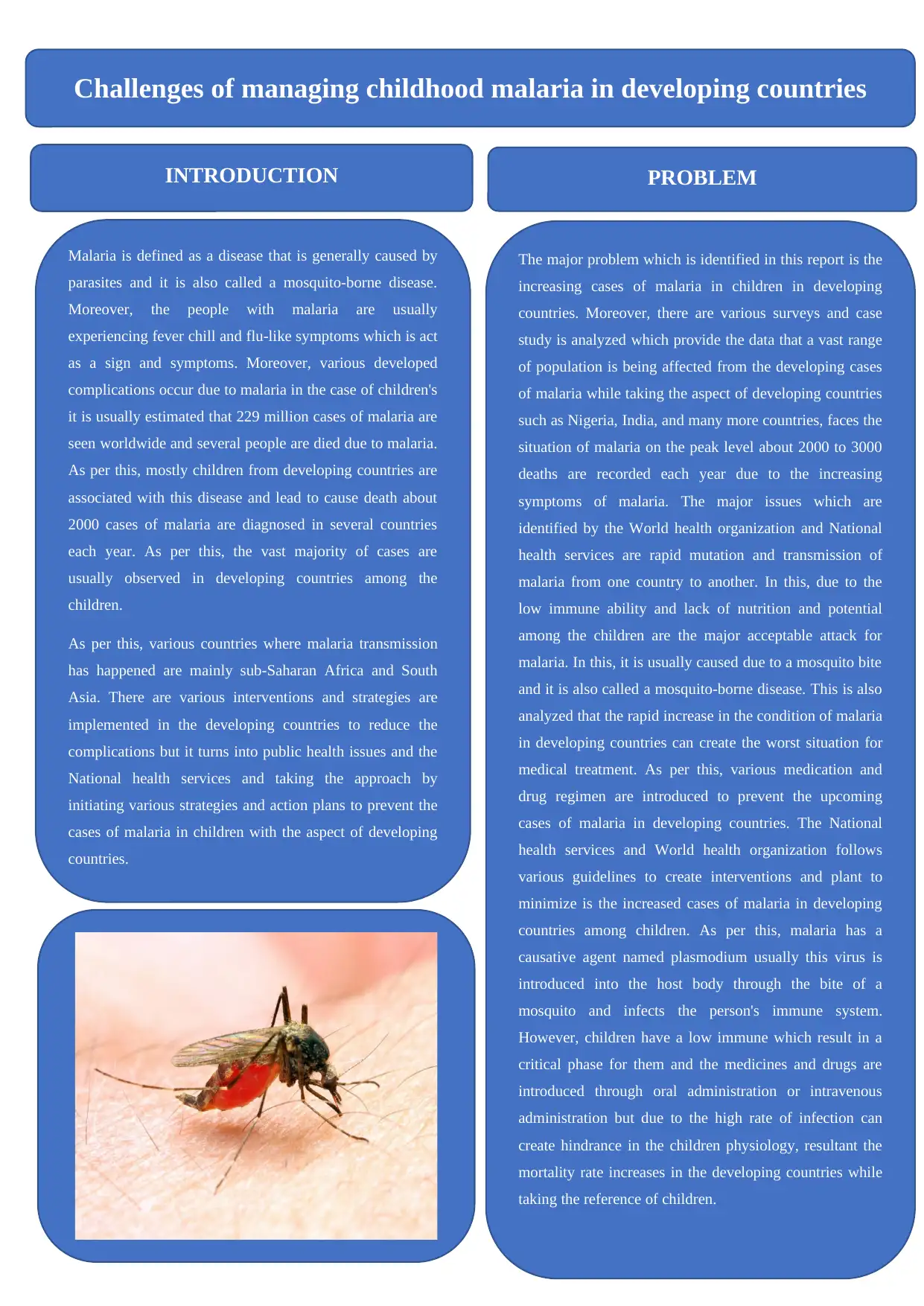
Challenges of managing childhood malaria in developing countries
INTRODUCTION
Malaria is defined as a disease that is generally caused by
parasites and it is also called a mosquito-borne disease.
Moreover, the people with malaria are usually
experiencing fever chill and flu-like symptoms which is act
as a sign and symptoms. Moreover, various developed
complications occur due to malaria in the case of children's
it is usually estimated that 229 million cases of malaria are
seen worldwide and several people are died due to malaria.
As per this, mostly children from developing countries are
associated with this disease and lead to cause death about
2000 cases of malaria are diagnosed in several countries
each year. As per this, the vast majority of cases are
usually observed in developing countries among the
children.
As per this, various countries where malaria transmission
has happened are mainly sub-Saharan Africa and South
Asia. There are various interventions and strategies are
implemented in the developing countries to reduce the
complications but it turns into public health issues and the
National health services and taking the approach by
initiating various strategies and action plans to prevent the
cases of malaria in children with the aspect of developing
countries.
PROBLEM
The major problem which is identified in this report is the
increasing cases of malaria in children in developing
countries. Moreover, there are various surveys and case
study is analyzed which provide the data that a vast range
of population is being affected from the developing cases
of malaria while taking the aspect of developing countries
such as Nigeria, India, and many more countries, faces the
situation of malaria on the peak level about 2000 to 3000
deaths are recorded each year due to the increasing
symptoms of malaria. The major issues which are
identified by the World health organization and National
health services are rapid mutation and transmission of
malaria from one country to another. In this, due to the
low immune ability and lack of nutrition and potential
among the children are the major acceptable attack for
malaria. In this, it is usually caused due to a mosquito bite
and it is also called a mosquito-borne disease. This is also
analyzed that the rapid increase in the condition of malaria
in developing countries can create the worst situation for
medical treatment. As per this, various medication and
drug regimen are introduced to prevent the upcoming
cases of malaria in developing countries. The National
health services and World health organization follows
various guidelines to create interventions and plant to
minimize is the increased cases of malaria in developing
countries among children. As per this, malaria has a
causative agent named plasmodium usually this virus is
introduced into the host body through the bite of a
mosquito and infects the person's immune system.
However, children have a low immune which result in a
critical phase for them and the medicines and drugs are
introduced through oral administration or intravenous
administration but due to the high rate of infection can
create hindrance in the children physiology, resultant the
mortality rate increases in the developing countries while
taking the reference of children.
INTRODUCTION
Malaria is defined as a disease that is generally caused by
parasites and it is also called a mosquito-borne disease.
Moreover, the people with malaria are usually
experiencing fever chill and flu-like symptoms which is act
as a sign and symptoms. Moreover, various developed
complications occur due to malaria in the case of children's
it is usually estimated that 229 million cases of malaria are
seen worldwide and several people are died due to malaria.
As per this, mostly children from developing countries are
associated with this disease and lead to cause death about
2000 cases of malaria are diagnosed in several countries
each year. As per this, the vast majority of cases are
usually observed in developing countries among the
children.
As per this, various countries where malaria transmission
has happened are mainly sub-Saharan Africa and South
Asia. There are various interventions and strategies are
implemented in the developing countries to reduce the
complications but it turns into public health issues and the
National health services and taking the approach by
initiating various strategies and action plans to prevent the
cases of malaria in children with the aspect of developing
countries.
PROBLEM
The major problem which is identified in this report is the
increasing cases of malaria in children in developing
countries. Moreover, there are various surveys and case
study is analyzed which provide the data that a vast range
of population is being affected from the developing cases
of malaria while taking the aspect of developing countries
such as Nigeria, India, and many more countries, faces the
situation of malaria on the peak level about 2000 to 3000
deaths are recorded each year due to the increasing
symptoms of malaria. The major issues which are
identified by the World health organization and National
health services are rapid mutation and transmission of
malaria from one country to another. In this, due to the
low immune ability and lack of nutrition and potential
among the children are the major acceptable attack for
malaria. In this, it is usually caused due to a mosquito bite
and it is also called a mosquito-borne disease. This is also
analyzed that the rapid increase in the condition of malaria
in developing countries can create the worst situation for
medical treatment. As per this, various medication and
drug regimen are introduced to prevent the upcoming
cases of malaria in developing countries. The National
health services and World health organization follows
various guidelines to create interventions and plant to
minimize is the increased cases of malaria in developing
countries among children. As per this, malaria has a
causative agent named plasmodium usually this virus is
introduced into the host body through the bite of a
mosquito and infects the person's immune system.
However, children have a low immune which result in a
critical phase for them and the medicines and drugs are
introduced through oral administration or intravenous
administration but due to the high rate of infection can
create hindrance in the children physiology, resultant the
mortality rate increases in the developing countries while
taking the reference of children.
Secure Best Marks with AI Grader
Need help grading? Try our AI Grader for instant feedback on your assignments.
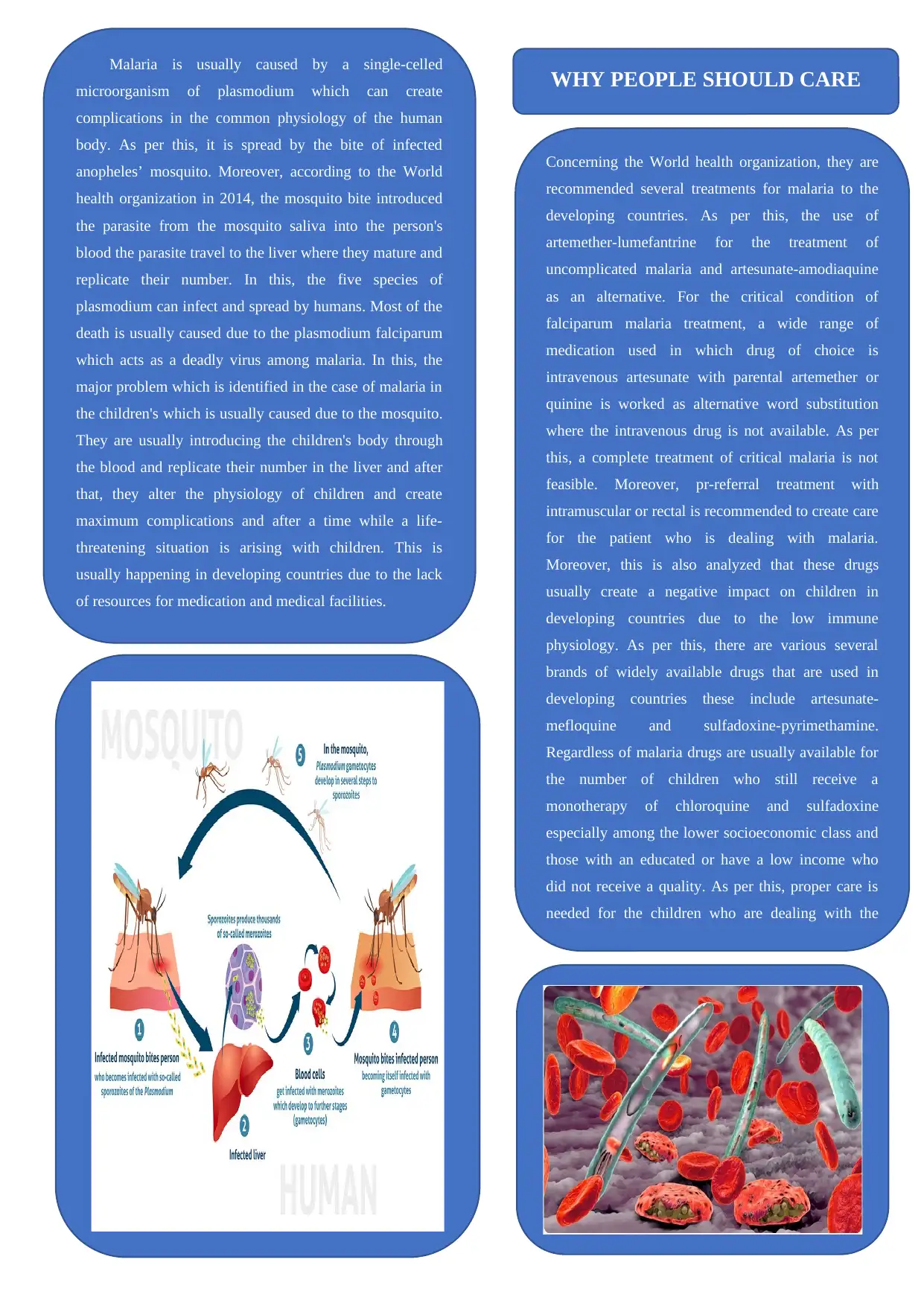
Malaria is usually caused by a single-celled
microorganism of plasmodium which can create
complications in the common physiology of the human
body. As per this, it is spread by the bite of infected
anopheles’ mosquito. Moreover, according to the World
health organization in 2014, the mosquito bite introduced
the parasite from the mosquito saliva into the person's
blood the parasite travel to the liver where they mature and
replicate their number. In this, the five species of
plasmodium can infect and spread by humans. Most of the
death is usually caused due to the plasmodium falciparum
which acts as a deadly virus among malaria. In this, the
major problem which is identified in the case of malaria in
the children's which is usually caused due to the mosquito.
They are usually introducing the children's body through
the blood and replicate their number in the liver and after
that, they alter the physiology of children and create
maximum complications and after a time while a life-
threatening situation is arising with children. This is
usually happening in developing countries due to the lack
of resources for medication and medical facilities.
WHY PEOPLE SHOULD CARE
Concerning the World health organization, they are
recommended several treatments for malaria to the
developing countries. As per this, the use of
artemether-lumefantrine for the treatment of
uncomplicated malaria and artesunate-amodiaquine
as an alternative. For the critical condition of
falciparum malaria treatment, a wide range of
medication used in which drug of choice is
intravenous artesunate with parental artemether or
quinine is worked as alternative word substitution
where the intravenous drug is not available. As per
this, a complete treatment of critical malaria is not
feasible. Moreover, pr-referral treatment with
intramuscular or rectal is recommended to create care
for the patient who is dealing with malaria.
Moreover, this is also analyzed that these drugs
usually create a negative impact on children in
developing countries due to the low immune
physiology. As per this, there are various several
brands of widely available drugs that are used in
developing countries these include artesunate-
mefloquine and sulfadoxine-pyrimethamine.
Regardless of malaria drugs are usually available for
the number of children who still receive a
monotherapy of chloroquine and sulfadoxine
especially among the lower socioeconomic class and
those with an educated or have a low income who
did not receive a quality. As per this, proper care is
needed for the children who are dealing with the
complications of malaria.
microorganism of plasmodium which can create
complications in the common physiology of the human
body. As per this, it is spread by the bite of infected
anopheles’ mosquito. Moreover, according to the World
health organization in 2014, the mosquito bite introduced
the parasite from the mosquito saliva into the person's
blood the parasite travel to the liver where they mature and
replicate their number. In this, the five species of
plasmodium can infect and spread by humans. Most of the
death is usually caused due to the plasmodium falciparum
which acts as a deadly virus among malaria. In this, the
major problem which is identified in the case of malaria in
the children's which is usually caused due to the mosquito.
They are usually introducing the children's body through
the blood and replicate their number in the liver and after
that, they alter the physiology of children and create
maximum complications and after a time while a life-
threatening situation is arising with children. This is
usually happening in developing countries due to the lack
of resources for medication and medical facilities.
WHY PEOPLE SHOULD CARE
Concerning the World health organization, they are
recommended several treatments for malaria to the
developing countries. As per this, the use of
artemether-lumefantrine for the treatment of
uncomplicated malaria and artesunate-amodiaquine
as an alternative. For the critical condition of
falciparum malaria treatment, a wide range of
medication used in which drug of choice is
intravenous artesunate with parental artemether or
quinine is worked as alternative word substitution
where the intravenous drug is not available. As per
this, a complete treatment of critical malaria is not
feasible. Moreover, pr-referral treatment with
intramuscular or rectal is recommended to create care
for the patient who is dealing with malaria.
Moreover, this is also analyzed that these drugs
usually create a negative impact on children in
developing countries due to the low immune
physiology. As per this, there are various several
brands of widely available drugs that are used in
developing countries these include artesunate-
mefloquine and sulfadoxine-pyrimethamine.
Regardless of malaria drugs are usually available for
the number of children who still receive a
monotherapy of chloroquine and sulfadoxine
especially among the lower socioeconomic class and
those with an educated or have a low income who
did not receive a quality. As per this, proper care is
needed for the children who are dealing with the
complications of malaria.
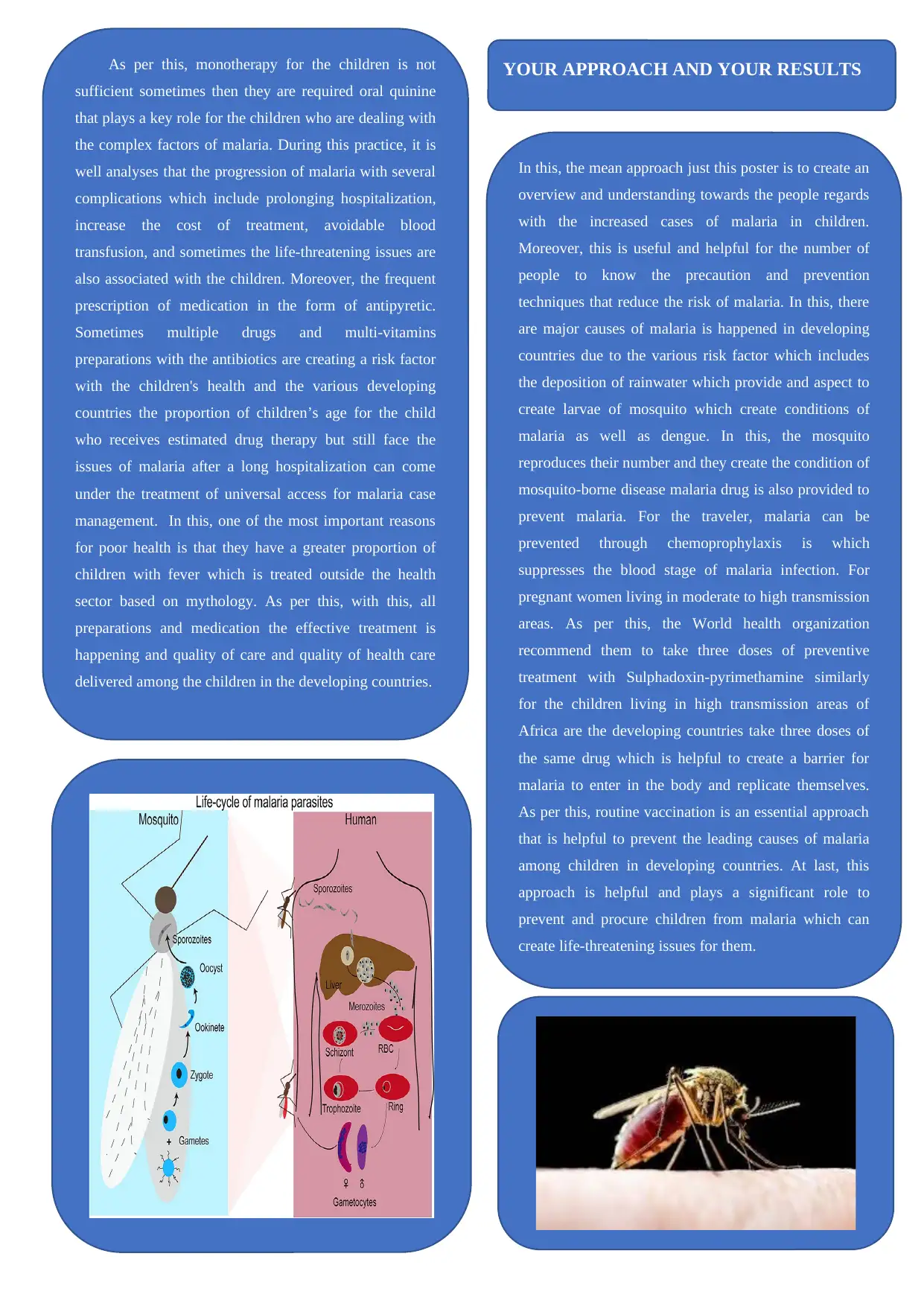
As per this, monotherapy for the children is not
sufficient sometimes then they are required oral quinine
that plays a key role for the children who are dealing with
the complex factors of malaria. During this practice, it is
well analyses that the progression of malaria with several
complications which include prolonging hospitalization,
increase the cost of treatment, avoidable blood
transfusion, and sometimes the life-threatening issues are
also associated with the children. Moreover, the frequent
prescription of medication in the form of antipyretic.
Sometimes multiple drugs and multi-vitamins
preparations with the antibiotics are creating a risk factor
with the children's health and the various developing
countries the proportion of children’s age for the child
who receives estimated drug therapy but still face the
issues of malaria after a long hospitalization can come
under the treatment of universal access for malaria case
management. In this, one of the most important reasons
for poor health is that they have a greater proportion of
children with fever which is treated outside the health
sector based on mythology. As per this, with this, all
preparations and medication the effective treatment is
happening and quality of care and quality of health care
delivered among the children in the developing countries.
YOUR APPROACH AND YOUR RESULTS
In this, the mean approach just this poster is to create an
overview and understanding towards the people regards
with the increased cases of malaria in children.
Moreover, this is useful and helpful for the number of
people to know the precaution and prevention
techniques that reduce the risk of malaria. In this, there
are major causes of malaria is happened in developing
countries due to the various risk factor which includes
the deposition of rainwater which provide and aspect to
create larvae of mosquito which create conditions of
malaria as well as dengue. In this, the mosquito
reproduces their number and they create the condition of
mosquito-borne disease malaria drug is also provided to
prevent malaria. For the traveler, malaria can be
prevented through chemoprophylaxis is which
suppresses the blood stage of malaria infection. For
pregnant women living in moderate to high transmission
areas. As per this, the World health organization
recommend them to take three doses of preventive
treatment with Sulphadoxin-pyrimethamine similarly
for the children living in high transmission areas of
Africa are the developing countries take three doses of
the same drug which is helpful to create a barrier for
malaria to enter in the body and replicate themselves.
As per this, routine vaccination is an essential approach
that is helpful to prevent the leading causes of malaria
among children in developing countries. At last, this
approach is helpful and plays a significant role to
prevent and procure children from malaria which can
create life-threatening issues for them.
sufficient sometimes then they are required oral quinine
that plays a key role for the children who are dealing with
the complex factors of malaria. During this practice, it is
well analyses that the progression of malaria with several
complications which include prolonging hospitalization,
increase the cost of treatment, avoidable blood
transfusion, and sometimes the life-threatening issues are
also associated with the children. Moreover, the frequent
prescription of medication in the form of antipyretic.
Sometimes multiple drugs and multi-vitamins
preparations with the antibiotics are creating a risk factor
with the children's health and the various developing
countries the proportion of children’s age for the child
who receives estimated drug therapy but still face the
issues of malaria after a long hospitalization can come
under the treatment of universal access for malaria case
management. In this, one of the most important reasons
for poor health is that they have a greater proportion of
children with fever which is treated outside the health
sector based on mythology. As per this, with this, all
preparations and medication the effective treatment is
happening and quality of care and quality of health care
delivered among the children in the developing countries.
YOUR APPROACH AND YOUR RESULTS
In this, the mean approach just this poster is to create an
overview and understanding towards the people regards
with the increased cases of malaria in children.
Moreover, this is useful and helpful for the number of
people to know the precaution and prevention
techniques that reduce the risk of malaria. In this, there
are major causes of malaria is happened in developing
countries due to the various risk factor which includes
the deposition of rainwater which provide and aspect to
create larvae of mosquito which create conditions of
malaria as well as dengue. In this, the mosquito
reproduces their number and they create the condition of
mosquito-borne disease malaria drug is also provided to
prevent malaria. For the traveler, malaria can be
prevented through chemoprophylaxis is which
suppresses the blood stage of malaria infection. For
pregnant women living in moderate to high transmission
areas. As per this, the World health organization
recommend them to take three doses of preventive
treatment with Sulphadoxin-pyrimethamine similarly
for the children living in high transmission areas of
Africa are the developing countries take three doses of
the same drug which is helpful to create a barrier for
malaria to enter in the body and replicate themselves.
As per this, routine vaccination is an essential approach
that is helpful to prevent the leading causes of malaria
among children in developing countries. At last, this
approach is helpful and plays a significant role to
prevent and procure children from malaria which can
create life-threatening issues for them.
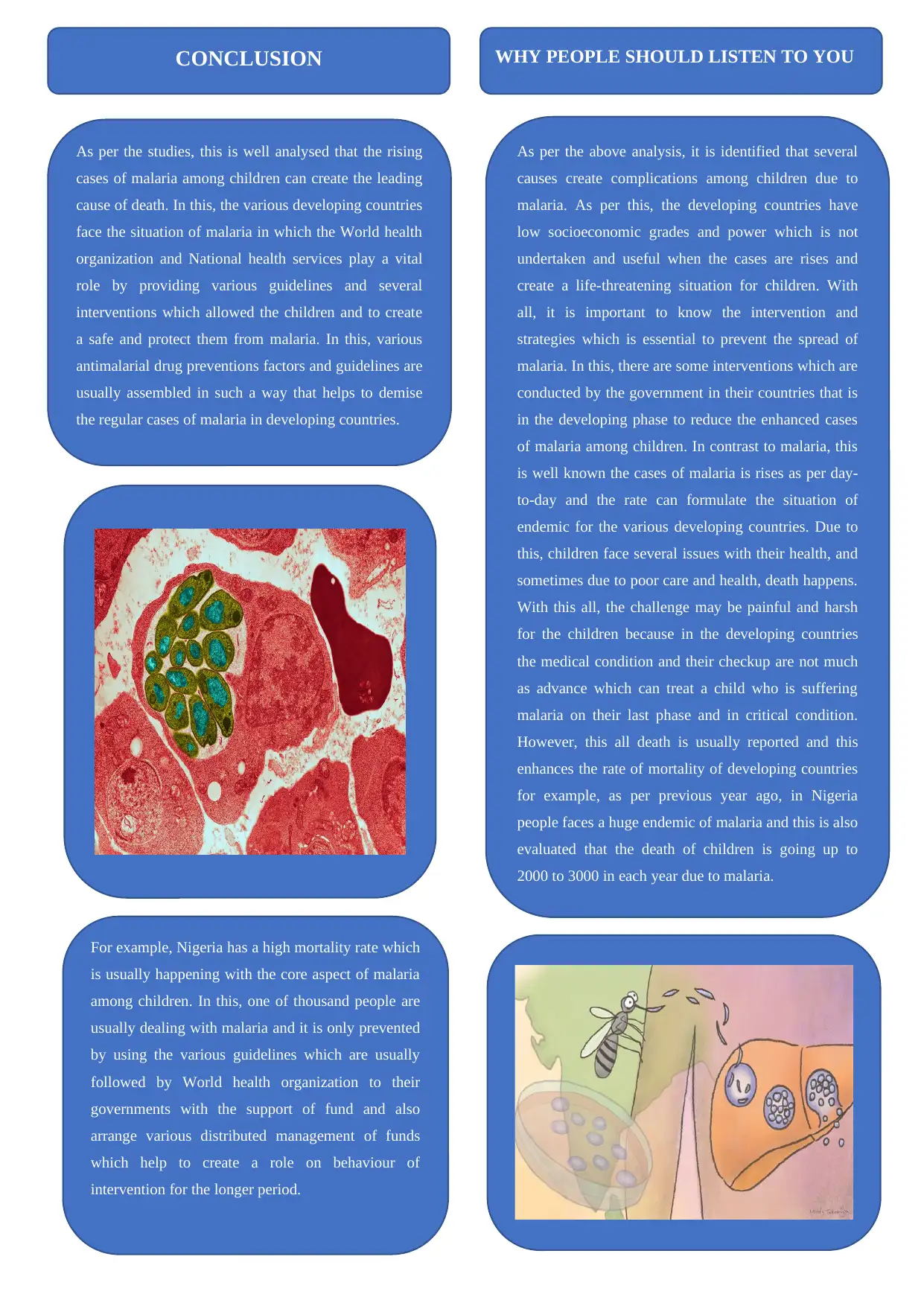
CONCLUSION
As per the studies, this is well analysed that the rising
cases of malaria among children can create the leading
cause of death. In this, the various developing countries
face the situation of malaria in which the World health
organization and National health services play a vital
role by providing various guidelines and several
interventions which allowed the children and to create
a safe and protect them from malaria. In this, various
antimalarial drug preventions factors and guidelines are
usually assembled in such a way that helps to demise
the regular cases of malaria in developing countries.
For example, Nigeria has a high mortality rate which
is usually happening with the core aspect of malaria
among children. In this, one of thousand people are
usually dealing with malaria and it is only prevented
by using the various guidelines which are usually
followed by World health organization to their
governments with the support of fund and also
arrange various distributed management of funds
which help to create a role on behaviour of
intervention for the longer period.
WHY PEOPLE SHOULD LISTEN TO YOU
As per the above analysis, it is identified that several
causes create complications among children due to
malaria. As per this, the developing countries have
low socioeconomic grades and power which is not
undertaken and useful when the cases are rises and
create a life-threatening situation for children. With
all, it is important to know the intervention and
strategies which is essential to prevent the spread of
malaria. In this, there are some interventions which are
conducted by the government in their countries that is
in the developing phase to reduce the enhanced cases
of malaria among children. In contrast to malaria, this
is well known the cases of malaria is rises as per day-
to-day and the rate can formulate the situation of
endemic for the various developing countries. Due to
this, children face several issues with their health, and
sometimes due to poor care and health, death happens.
With this all, the challenge may be painful and harsh
for the children because in the developing countries
the medical condition and their checkup are not much
as advance which can treat a child who is suffering
malaria on their last phase and in critical condition.
However, this all death is usually reported and this
enhances the rate of mortality of developing countries
for example, as per previous year ago, in Nigeria
people faces a huge endemic of malaria and this is also
evaluated that the death of children is going up to
2000 to 3000 in each year due to malaria.
As per the studies, this is well analysed that the rising
cases of malaria among children can create the leading
cause of death. In this, the various developing countries
face the situation of malaria in which the World health
organization and National health services play a vital
role by providing various guidelines and several
interventions which allowed the children and to create
a safe and protect them from malaria. In this, various
antimalarial drug preventions factors and guidelines are
usually assembled in such a way that helps to demise
the regular cases of malaria in developing countries.
For example, Nigeria has a high mortality rate which
is usually happening with the core aspect of malaria
among children. In this, one of thousand people are
usually dealing with malaria and it is only prevented
by using the various guidelines which are usually
followed by World health organization to their
governments with the support of fund and also
arrange various distributed management of funds
which help to create a role on behaviour of
intervention for the longer period.
WHY PEOPLE SHOULD LISTEN TO YOU
As per the above analysis, it is identified that several
causes create complications among children due to
malaria. As per this, the developing countries have
low socioeconomic grades and power which is not
undertaken and useful when the cases are rises and
create a life-threatening situation for children. With
all, it is important to know the intervention and
strategies which is essential to prevent the spread of
malaria. In this, there are some interventions which are
conducted by the government in their countries that is
in the developing phase to reduce the enhanced cases
of malaria among children. In contrast to malaria, this
is well known the cases of malaria is rises as per day-
to-day and the rate can formulate the situation of
endemic for the various developing countries. Due to
this, children face several issues with their health, and
sometimes due to poor care and health, death happens.
With this all, the challenge may be painful and harsh
for the children because in the developing countries
the medical condition and their checkup are not much
as advance which can treat a child who is suffering
malaria on their last phase and in critical condition.
However, this all death is usually reported and this
enhances the rate of mortality of developing countries
for example, as per previous year ago, in Nigeria
people faces a huge endemic of malaria and this is also
evaluated that the death of children is going up to
2000 to 3000 in each year due to malaria.
Secure Best Marks with AI Grader
Need help grading? Try our AI Grader for instant feedback on your assignments.
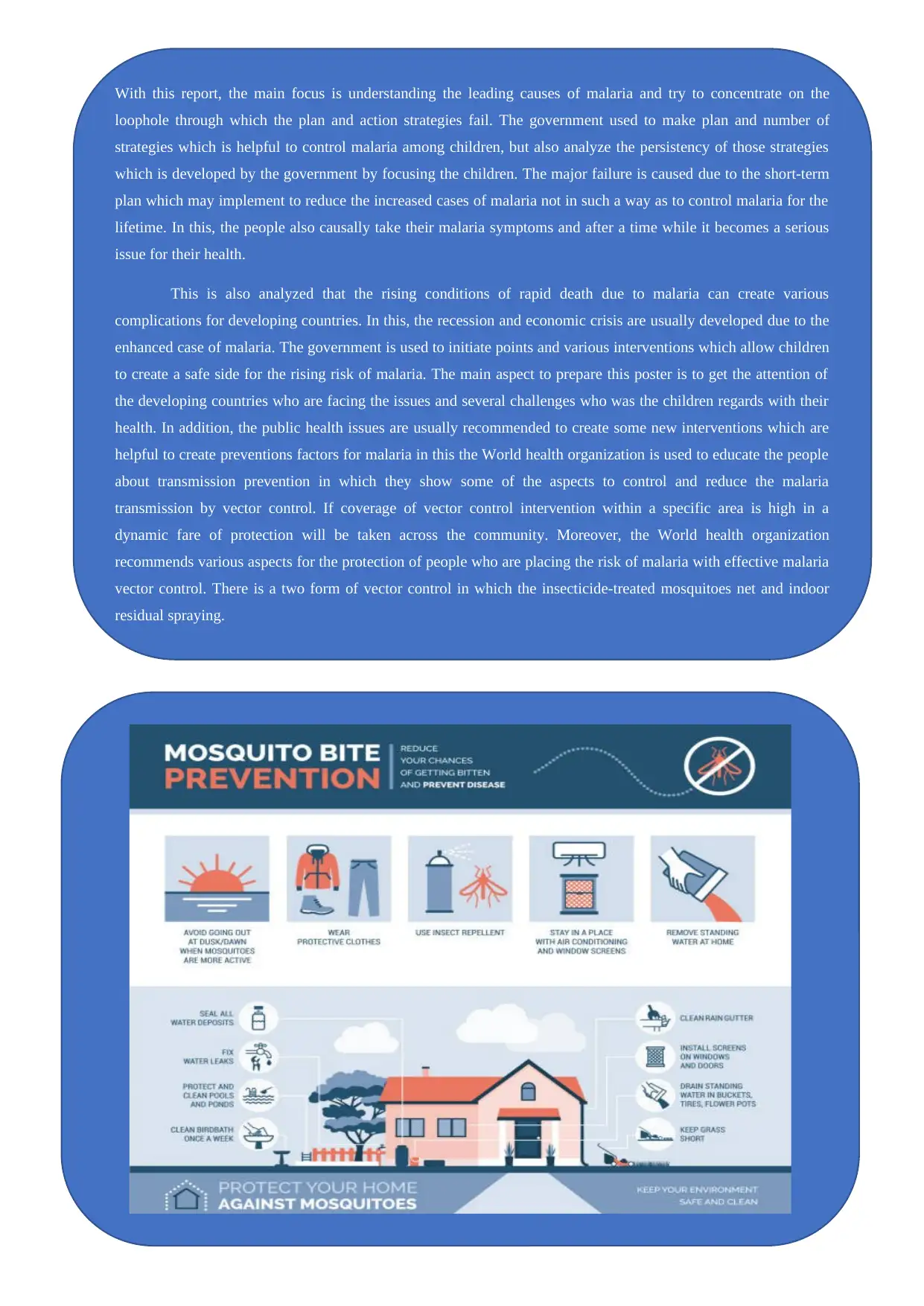
With this report, the main focus is understanding the leading causes of malaria and try to concentrate on the
loophole through which the plan and action strategies fail. The government used to make plan and number of
strategies which is helpful to control malaria among children, but also analyze the persistency of those strategies
which is developed by the government by focusing the children. The major failure is caused due to the short-term
plan which may implement to reduce the increased cases of malaria not in such a way as to control malaria for the
lifetime. In this, the people also causally take their malaria symptoms and after a time while it becomes a serious
issue for their health.
This is also analyzed that the rising conditions of rapid death due to malaria can create various
complications for developing countries. In this, the recession and economic crisis are usually developed due to the
enhanced case of malaria. The government is used to initiate points and various interventions which allow children
to create a safe side for the rising risk of malaria. The main aspect to prepare this poster is to get the attention of
the developing countries who are facing the issues and several challenges who was the children regards with their
health. In addition, the public health issues are usually recommended to create some new interventions which are
helpful to create preventions factors for malaria in this the World health organization is used to educate the people
about transmission prevention in which they show some of the aspects to control and reduce the malaria
transmission by vector control. If coverage of vector control intervention within a specific area is high in a
dynamic fare of protection will be taken across the community. Moreover, the World health organization
recommends various aspects for the protection of people who are placing the risk of malaria with effective malaria
vector control. There is a two form of vector control in which the insecticide-treated mosquitoes net and indoor
residual spraying.
loophole through which the plan and action strategies fail. The government used to make plan and number of
strategies which is helpful to control malaria among children, but also analyze the persistency of those strategies
which is developed by the government by focusing the children. The major failure is caused due to the short-term
plan which may implement to reduce the increased cases of malaria not in such a way as to control malaria for the
lifetime. In this, the people also causally take their malaria symptoms and after a time while it becomes a serious
issue for their health.
This is also analyzed that the rising conditions of rapid death due to malaria can create various
complications for developing countries. In this, the recession and economic crisis are usually developed due to the
enhanced case of malaria. The government is used to initiate points and various interventions which allow children
to create a safe side for the rising risk of malaria. The main aspect to prepare this poster is to get the attention of
the developing countries who are facing the issues and several challenges who was the children regards with their
health. In addition, the public health issues are usually recommended to create some new interventions which are
helpful to create preventions factors for malaria in this the World health organization is used to educate the people
about transmission prevention in which they show some of the aspects to control and reduce the malaria
transmission by vector control. If coverage of vector control intervention within a specific area is high in a
dynamic fare of protection will be taken across the community. Moreover, the World health organization
recommends various aspects for the protection of people who are placing the risk of malaria with effective malaria
vector control. There is a two form of vector control in which the insecticide-treated mosquitoes net and indoor
residual spraying.
1 out of 5
Related Documents
Your All-in-One AI-Powered Toolkit for Academic Success.
+13062052269
info@desklib.com
Available 24*7 on WhatsApp / Email
![[object Object]](/_next/static/media/star-bottom.7253800d.svg)
Unlock your academic potential
© 2024 | Zucol Services PVT LTD | All rights reserved.





